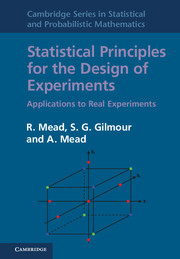Book contents
8 - Multiple blocking systems and cross-over designs
from Part II - First subject
Published online by Cambridge University Press: 05 November 2012
Summary
Preliminary examples
(a) An experiment to examine the pattern of variation over time of a particular chemical constituent of blood involved sampling the blood of nine chickens on 25 weekly occasions. The principal interest is in the variation of the chemical over the 25 times, the nine chickens being included to provide replication. The chemical analysis is complex and long and a set of at most ten blood samples can be analysed concurrently. It is known that there may be substantial differences in the results of the chemical analysis between different sets of samples. How should the 225 samples (25 times for nine chickens) be allocated to sets of ten (or fewer) so that comparisons between the 25 times are made as precise as possible?
(b) In an experiment to compare diets for cows the experimenter has five diet treatments that he wishes to compare. The diets have to be fed to fistulated (surgically prepared) cows so that the performance of the cows can be monitored throughout the application of each diet. Nine such cows are available for sufficient time that four periods of observation can be used for each cow, providing a set of 9 × 4 = 36 observations. Concerned that there will be differences between cows, so that cows have to be treated as a blocking structure, the experimenter had already decided before consulting a statistician that he could only test four of the diet treatments, each cow receiving each diet once.
Information
- Type
- Chapter
- Information
- Statistical Principles for the Design of ExperimentsApplications to Real Experiments, pp. 182 - 217Publisher: Cambridge University PressPrint publication year: 2012
